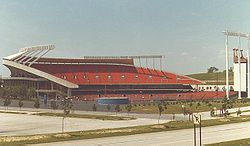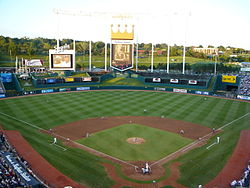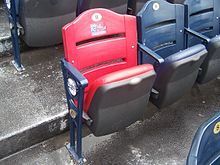- Kauffman Stadium
-
Kauffman Stadium "The K."
Royals Stadium
"Kauffman"Former names Kauffman Stadium (1994-2011) Royals Stadium (1973–1993) Location One Royal Way
Kansas City, Missouri 64129-6969Coordinates 39°3′5″N 94°28′50″W / 39.05139°N 94.48056°WCoordinates: 39°3′5″N 94°28′50″W / 39.05139°N 94.48056°W Broke ground July 11, 1968[1] Opened April 10, 1973 Renovated 2007-2009 Owner Jackson County Sports Complex Authority Operator Jackson County Sports Complex Authority[2] Surface Grass (mix of bluegrass and rye, 1995-Present)
AstroTurf (1973-1994)Construction cost $70 million USD
$250 million (2007-10 renovations)
($346 million in 2011 dollars[3])
Renovations: ($250 million in 2011 dollars[3])Architect Kivett and Myers Capacity 37,903 [4]
with standing room at least
40,055 (2010)[2]
40,625 (1973)
38,177 (2009)[5]Field dimensions Left Field - 330 feet (101 m)
Left-Center - 387 feet (118 m)
Center Field - 410 feet (125 m)
Right-Center - 387 feet (118 m)
Right Field - 330 feet (101 m)
Backstop - 60 feet (18 m)Tenants Kansas City Royals (MLB) (1973–present) Ewing M. Kauffman Stadium (
 /ˈkɔːfmən/; and also formerly known as Royals Stadium nicknamed The K.) is a Major League Baseball stadium located in Kansas City, Missouri, and home to the Kansas City Royals of the American League. Together with Arrowhead Stadium, home of the National Football League's Kansas City Chiefs, it is a part of the Truman Sports Complex. Since July 2, 1993, the venue had been known as Kauffman Stadium in honor of the Royals' founding owner, Ewing Kauffman.
/ˈkɔːfmən/; and also formerly known as Royals Stadium nicknamed The K.) is a Major League Baseball stadium located in Kansas City, Missouri, and home to the Kansas City Royals of the American League. Together with Arrowhead Stadium, home of the National Football League's Kansas City Chiefs, it is a part of the Truman Sports Complex. Since July 2, 1993, the venue had been known as Kauffman Stadium in honor of the Royals' founding owner, Ewing Kauffman.Kauffman Stadium was built specifically for baseball during an era where building multisport "cookie-cutter" stadiums were commonplace. It is often held up along with Dodger Stadium in Los Angeles as one of the best examples of modernist stadium design.
It is the only ballpark in the American League to currently be named after a person (Ewing Kauffman). The stadium is 38 years old, making it the sixth-oldest stadium in major-league baseball. Kauffman stadium recently underwent a $250 million renovation, which began after the 2007 season and was completed in July 2009.[6]
The 2012 Major League Baseball All-Star Game will be held at Kauffman Stadium.
Contents
History
In 1967, voters in Jackson County, Missouri, approved the bonds for Truman Sports Complex, which featured a football stadium for the Kansas City Chiefs and a baseball stadium for the Kansas City Athletics, whose owner, Charles O. Finley, had just signed a new lease to remain in Kansas City. This was unusual for the time; it was long considered conventional wisdom that separate football and baseball stadiums were not commercially viable. Before the 1968 season, however, Finley moved the A's to Oakland, California, and their brand-new multi-purpose stadium.
 A game at Royals Stadium on Sunday, September 19, 1976. The pitcher is Chris Knapp and the batter is Tom Poquette. The Royals would beat the White Sox 6 to 5.
A game at Royals Stadium on Sunday, September 19, 1976. The pitcher is Chris Knapp and the batter is Tom Poquette. The Royals would beat the White Sox 6 to 5.
After the move, Missouri Senator Stuart Symington threatened to revoke baseball's anti-trust exemption if they did not give Kansas City a new team. Baseball responded by hastily granting expansion franchises to four cities, including a Kansas City team owned by local pharmaceutical magnate Ewing Kauffman. The new teams were due to start play in 1971, but pressure from Symington forced them to move up the start date to 1969. Jackson County continued its plans to build a new ballpark. After playing four seasons in Kansas City Municipal Stadium, on April 10, 1973, the Royals inaugurated Royals Stadium with a win over the Texas Rangers.
On May 15, 1973, the stadium, barely a month into its existence, saw Nolan Ryan, pitching for the California Angels, throw the first of his seven no-hitters, blanking the Royals 3–0.
On July 24, 1973, Royals Stadium hosted its first of two Major League Baseball All-Star Games.
On October 9, 1976, the Royals competed in their first post-season game in franchise history, losing 4–1 to the New York Yankees at Royals Stadium in the American League Championship Series. The Royals came back to win the next game on October 10, 6–3, for their first post-season win in Royals Stadium.
On October 17, 1980, the first World Series game held in Kansas City featured the hometown Royals against the Philadelphia Phillies. In his first at-bat, George Brett hit a home run down the right field line. The Royals would go on to record their first-ever World Series win, 4–3 in 10 innings. However, the Royals would lose the World Series that year in six games.
On October 11, 1985, in Game 3 of the American League Championship Series, George Brett hit two home runs off Toronto Blue Jays pitcher Doyle Alexander, made a back-handed stop at third base to throw out a runner at home, and recorded the final out to give the Royals a much-needed 6–5 win. The Royals went on to win the American League pennant in seven games.
On October 27 of that same year, the Royals clinched their first World Series title in franchise history, winning Game 7 in Royals Stadium. Led by the pitching of Bret Saberhagen, Darryl Motley's two-run home run, and George Brett's four hits, the Royals beat the St. Louis Cardinals 11–0. The Royals were the first team in the history of the World Series to lose the first two games of the series at home and come back to win.
On June 16, 2010, MLB Commissioner Bud Selig announced that Kauffman Stadium has been awarded the 2012 MLB All-Star game.
Features
Kauffman Stadium was the last baseball-only park built in the majors (not counting temporary facilities) from 1966 to 1991. It was one of the few baseball-only facilities built in the majors during the heyday of the cookie-cutter stadium era, and is one of two such facilities (Dodger Stadium is the other) that are still active and were never converted for use as multi-purpose stadiums.1
Although it is a baseball-only facility, its design took several stylistic cues from the multi-purpose stadiums of the day. The main stadium itself is primarily concrete, with a smooth, uncovered concrete facade. The stands wrap around the infield and end at the foul poles, with smaller bleacher sections (or "outfield plazas," as the Royals call them) in the outfield. In their book, The Ultimate Baseball Road Trip, Josh Pahigaian and Kevin O'Connell described it as one-third of a cookie-cutter stadium.[7] The upper deck is quite steep, though not as high as other parks built during this time. Many minor-league stadiums built in the 1980s and early 1990s, as well as U.S. Cellular Field in Chicago, employ a similar design.
The sight lines are generally very good; the only seriously obstructed views are in the outfield plazas, where some seats are directly behind the foul poles. Many of the seats in the two view levels are almost as high as comparable seats in cookie-cutter stadiums, especially in the back rows. Most of the seats are on the first level, putting most of the fans very close to the action.
By 2000, all of the seats were replaced by blue seats, the lower section seating also getting cupholders.
The park's best-known feature is the fountain and waterfall display (known as the Water Spectacular) behind the right-field fence. At 322 feet, it is the largest privately-funded fountain in the world.[7] The fountains are on display before and after the game and in-between innings, while the waterfalls are constantly flowing.
When the stadium was originally built, Kansas City was the westernmost major league city other than those along the Pacific Coast (1,600 miles away), which was a major reason why the Royals initially decided to use a faster-draining AstroTurf surface.[8] The Royals' home territory included a large swath of the Great Plains and Rockies, and Kauffman didn't want fans who drove many hundreds of miles to go home without seeing the game completed. The Truman Sports Complex's legendary groundskeeper, George Toma, best known as the head groundskeeper for every Super Bowl, thus had the ironic job of maintaining two carpets for most of his career, along with the surface of Arrowhead Stadium, which had AstroTurf from 1972 through 1993.
The arrival of the Colorado Rockies, however, removed virtually all of the western portion of the Royals' once-vast home territory. Also in 1995, the stadium's turf was replaced by grass for the season. When the Royals ripped out the turf, 4 inch perforated tile was installed at 12.5-foot centers across the entire field. As a result, the current grass field drains very well. Many newer facilities (and some older facilities through retrofitting) have similar drainage systems to minimize downtime after rain delays.
Renovations
On April 4, 2006, Jackson County, Missouri voters approved a 0.375-percentage point sales tax increase to fund plans to renovate the Truman Sports Complex. The construction began with a ceremonial groundbreaking inside Kauffman Stadium on October 3, 2007, with completion of Kauffman Stadium in time for Opening Day in 2009, and full renovation of the complex (including nearby Arrowhead Stadium) by 2010, depending upon cost overruns. The team committed to a lease that will keep them in Kansas City until 2030, an extension of their current lease expiration of 2015. The improvements to Kauffman Stadium included the following:
- Reducing capacity to 37,903
- New high definition scoreboard, dubbed "Crown Vision" and control room
- Fountain view terraces
- Outfield concourse
- Kids' area
- Taste of KC
- Right field sports bar-themed restaurant
- Left field hall of fame and conference center
- New group sales areas
- Wider concourses
- New and upgraded concession and toilet amenities on all concourses
- Enhanced vertical circulation to all levels
- Four new entry ticket gates
- New press facilities
The new high-definition scoreboard from Daktronics of Brookings, South Dakota was one of the first features to be installed.[9] It replaced both the old matrix board in the shape of the Royals logo that had been in the park since its opening, along with the video board that had been installed in 1989. The new scoreboard was ready for Opening Day 2008. It is 84 ft. wide and 105 ft. tall, and was, at the time it entered service, the largest high-definition LED display in the world.[10] The display was assembled in 55 separate segments, including an active bottom taper to resemble the shield in the Royals logo. The video scoreboard alone cost $8.3 million, and the control room that operates it is staffed with 17 people on game days.[11] It was adorned with a crown during the 2008 offseason. Strobe lights atop the scoreboard flash after every Royals home run.
Also, since this measure passed, MLB has announced that Kauffman Stadium will host the MLB All-Star Game in 2012.[12] As part of this measure, every Jackson County residential address will receive vouchers good for 50% off two tickets at Royals games on certain nights.
A second proposal on the April 2006 ballot would have installed a rolling roof at the Truman Sports Complex. The roof could have been moved to cover either Kauffman Stadium or Arrowhead Stadium when needed. The measure failed at the polls.
Buck O'Neil legacy seat
Beginning with the 2007 season, the Royals had a red seat placed in the stadium amongst the all-blue seats behind home plate to honor Buck O'Neil. There will be a person selected every game from community nominees to sit in that seat, formerly occupied by O'Neil behind home plate in what was Section 101, Row C, Seat 1, until 2008 who embodies the spirit of Buck O'Neil. Due to the renovations and section renumbering in 2009 the seat number is now Section 127, Seat 9, Row C and the seat bottom is now padded.
Notes
- ^ http://kansascity.royals.mlb.com/kc/ballpark/history/index.jsp
- ^ http://www.jcsca.org/
- ^ a b Consumer Price Index (estimate) 1800–2008. Federal Reserve Bank of Minneapolis. Retrieved December 7, 2010.
- ^ http://kansascity.royals.mlb.com/kc/ballpark/information/index.jsp?content=moreinfo Royals.com
- ^ Kansas City Star April 6, 2009 Page: A9
- ^ http://kansascity.royals.mlb.com/kc/ballpark/renovation_timeline.jsp
- ^ a b Pahigaian, Josh; Kevin O'Connell (2004). The Ultimate Baseball Road Trip. Guilford, Connecticut: Lyons Press. ISBN 1592281591.
- ^ Smith, Curt (2001). Storied Stadiums. New York City: Carroll & Graf. ISBN 0786711876.
- ^ http://www.ledsmagazine.com/press/15528 |title=Daktronics installs world's largest HD display for Kansas City Royals
- ^ www.businesswire.com | 10/03/2007 | Royals Fans to Watch Highlights and Replays on World’s Largest HD Display
- ^ www.kansascity.com | 04/08/2008 | Royals scoreboard is a vision of the future
- ^ [1]]
^Note 1 : Candlestick Park (1960), Anaheim Stadium (1966), and Jarry Park Stadium (1969) were all originally built as baseball-only facilities. Candlestick Park is no longer an active MLB park, and Jarry Park Stadium was renovated into Stade Uniprix, a tennis-specific stadium with only a small portion of the original stadium present. Both Candlestick Park and Anaheim Stadium were converted to multi-purpose facilities. Anaheim Stadium, now known as Angel Stadium of Anaheim, was re-converted into a baseball-only facility in 1996.
External links
Events and tenants Preceded by
Municipal StadiumHome of the Kansas City Royals
1973 – presentSucceeded by
CurrentPreceded by
Atlanta-Fulton County Stadium
Chase FieldHost of the MLB All-Star Game
1973
2012Succeeded by
Three Rivers Stadium
TBDThe Kansas City Area Kansas City • The Metro Area • History • Economy • Neighborhoods • Architecture • Fountains • Barbecue • Jazz • Broadcast • Film • Education • SportsKansas City Royals The franchise History • Expansion Draft • Seasons • Current Roster • Owners and executives • Managers • Opening Day starting pitchers • All-Time Roster • First-round draft picks • Team Records • No-hitters • Awards & League Leaders • Broadcasters • Fox Sports Kansas City • Royals Sports Television NetworkBallparks Municipal Stadium • Kauffman Stadium
Spring Training: Terry Park • Baseball City Stadium • Surprise StadiumCulture Rivalries St. Louis CardinalsTeam Hall of Fame Steve Busby • Amos Otis • Dick Howser • Cookie Rojas • Paul Splittorff • Dennis Leonard • Hal McRae • Joe Burke • Larry Gura • Freddie Patek • Ewing Kauffman • George Brett • Frank White • Muriel Kauffman • John Mayberry • Dan Quisenberry • Whitey Herzog • Willie Wilson • Jeff Montgomery • Denny Matthews • Bret Saberhagen • Mark Gubicza • Art StewartRetired numbers Minors Key personnel World Series
championships (1)American League
pennants (2)Division titles Seasons (43) 1960s 1970s 1980s 1990s 2000s 2010s 2010 • 2011 • 2012Current ballparks in Major League Baseball American League EastCentralWestNational League EastCentralWestCategories:- Kansas City Royals stadiums
- Major League Baseball venues
- Buildings and structures completed in 1973
- 1973 establishments
- Sports venues in Kansas City, Missouri
- Baseball venues in Missouri
Wikimedia Foundation. 2010.





